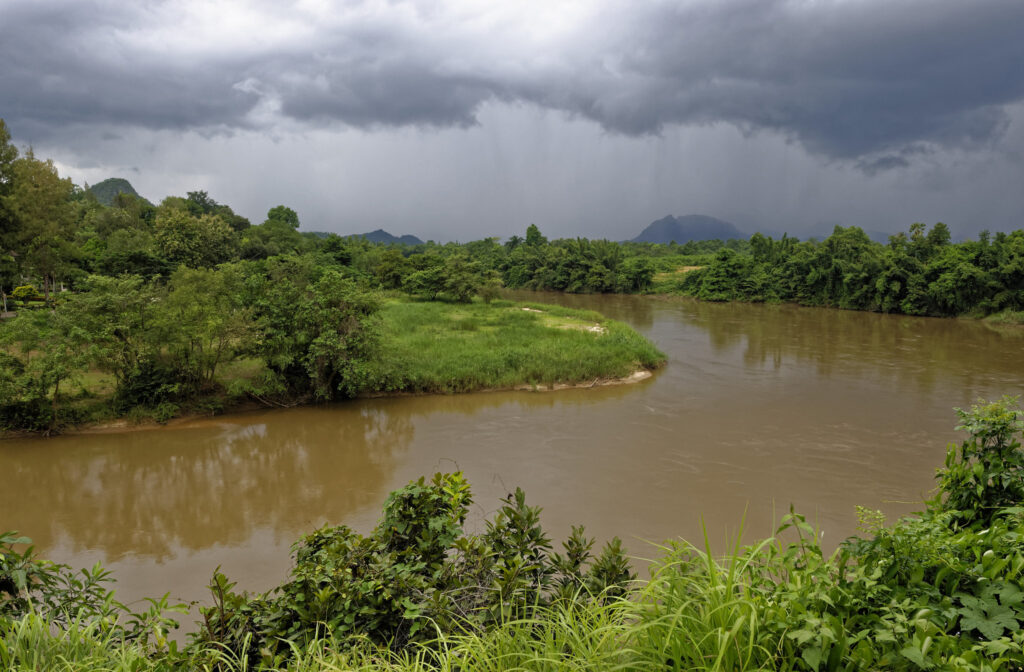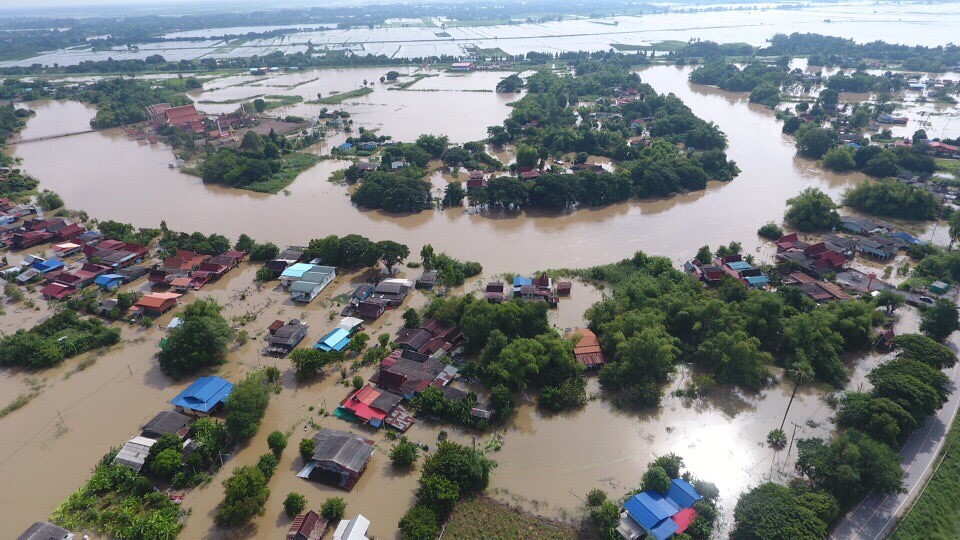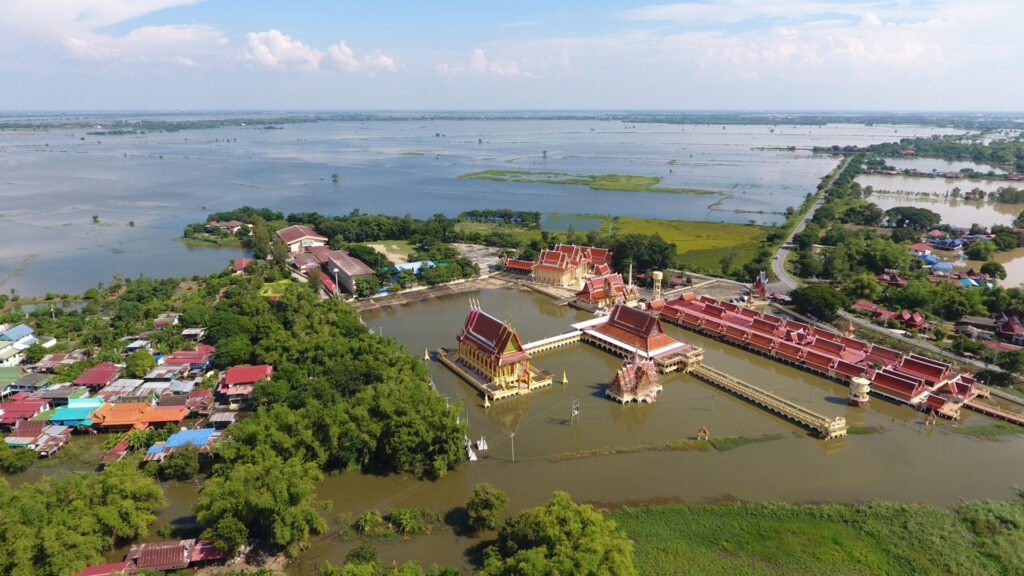Water is essential for all forms of life. It also underpins food security, economic prosperity and public health. This is especially so in Thailand, a country transited by some of Southeast Asia’s mightiest watercourses and whose growing national economy depends heavily on irrigated crops like rice. But as climate change continues to bring extreme weather events that exacerbate floods and droughts, Thailand’s farmers, communities and policymakers are facing the challenge of how to manage water sustainably.
One promising avenue is leveraging nature’s own capacity to mitigate the consequences of extreme weather by encouraging natural processes in Thailand’s abundant rivers, floodplains and watershed forests. Such ecosystem-based adaptations or nature-based solutions are increasingly being promoted worldwide as ways to address the climate crisis while enhancing the resilience of biodiversity, ecosystems and communities.
With the latest assessment of the Global Climate Risk Index ranking Thailand among the world’s top 10 countries most at risk of climate change, authorities and communities are trialing nature-based approaches in several parts of the country, and they’re increasingly reflected in national policy and planning instruments.
“Some challenges, such as achieving the U.N. Sustainable Development Goals or dealing with climate uncertainty, cannot be fully addressed without nature-based solutions and ecosystem-based adaptation playing an important part,” Aksara Putthividiya, associate professor at Chulalongkorn University in Bangkok, told Mongabay in an interview.

A new report, led by researchers based at five Thai universities, synthesizes data gathered between 2020 and 2022 on two ecosystems-based approaches to water management in Thailand: recreating seminatural floodplains; and constructing “living weirs,” a practice that involves regulating the flow of smaller watercourses using natural materials.
The projects studied were all established within the past decade as collaborations between national and local government departments, Thai academics and local communities, and the assessment report was produced in partnership with the German international development agency (GIZ) and the U.N. Environment Programme’s World Conservation Monitoring Centre (UNEP-WCMC).
The team found that the initiatives have achieved broadly positive outcomes for disaster risk reduction and local communities while mitigating harm to ecosystems. However, they identified some concerning environmental and socioeconomic tradeoffs that underscore the importance of ongoing monitoring to fine-tune projects and ensure they’re not causing unintended impacts.
“There is potential to apply [ecosystem-based adaptation] more widely and systematically,” Charlotte Hicks, senior technical officer of climate change and biodiversity at UNEP-WCMC, told Mongabay in an email. “Yet, so far, evidence on the socio-economic and ecological impacts and benefits of these solutions is still limited and thus hampers uptake by governments and other actors.”
A combined approach
Thailand’s water management strategies have traditionally followed a top-down approach, with authorities typically favoring large-scale, hard-engineered solutions, such as canals, tunnels, dikes and large-scale storage reservoirs, over locally driven, smaller-scale initiatives.
But a growing body of evidence indicates that in the face of intensifying climate threats, these engineering-based approaches create a false sense of security, but no longer deliver adequate flood protection or environmental sustainability. A 2021 study focused on the Chao Phraya River Basin, for instance, concluded that nature-based solutions such as green roofing and networks of ponds combined with traditional engineered structures offer far more effective and sustainable ways forward.
In response, Thailand’s Office of National Water Resources (ONWR) and other agencies that oversee the country’s water management, are gradually opening up to nature-based solutions. Measures such as wetland rehabilitation and protection, watershed forest restoration, and combinations of traditional engineering and nature-based solutions now feature in Thailand’s 20-year National Water Resources Management Master Plan (2018-2037) and the country’s 2021-2030 plan for cutting greenhouse gas emissions under the Paris climate agreement.
In addition to government-led schemes, ecosystem-based measures can also empower small-scale farmers and local communities to manage impending climate risks, according to Chaiwat Rongsayamanont, associate professor at Prince of Songkhla University in the city of Hat Yai and a contributor to the report.
“People don’t want to face a big risk of flood or droughts. They cannot wait for several years to get a big reservoir [or] irrigation system to get water supply for their farm, so they need to build their own solution by using ecosystem-based initiatives,” Chaiwat told Mongabay in an interview.
Living weirs
One of the initiatives the new report assessed is a series of living weirs along the Khlong-La River in Songkhla province and the Khlong Wang Heep River in Nakhon Si Thammarat province. The projects were spurred by severe droughts between 2014 and 2016, prompting local researchers and community members to find affordable and timely solutions.
Community-led construction groups built the weirs by laying bamboo grids across the width of the watercourses. They then infilled the bamboo structures with natural materials to form a low dam, or weir, that raises the level of the water upstream and somewhat regulates the flow downstream. Lastly, the teams planted trees and other vegetation along the riverbanks to stabilize the ground and eventually revegetate the weir itself.

By conducting hydrological, ecological and water quality monitoring and interviewing local stakeholders, the researchers found that the weirs helped retain water during the dry season and slow the river flow in the wet season, particularly during times of heavy rainfall that could otherwise cause harmful flooding. This broadly resulted in more water availability for farmers to irrigate their fields during the dry season and for domestic use by the community.
Households living close to the living weirs reported they were less affected by flooding or water shortages after the weirs were installed, despite higher than average rainfall and more intense dry season droughts during the years following construction.
Chaiwat said the main social outcome from the living weirs was enhanced relations between the local community and local government, who have typically come into conflict over water management, but worked well together to build and manage the weirs.
“It was easy to get people to participate because people could clearly see the benefit of the living weir construction,” Chaiwat said. “We had faced big droughts [but] after they built the first weir, it showed that this was a way to retain a lot of water … it gave people hope.”
According to the report, however, there are likely to be as-yet-unmeasured impacts on local species distributions and ecosystem services due to altered river flow. Furthermore, the report raised concerns over pollution associated with disintegration of non-biodegradable sandbags used to infill some of the weirs.
Floodplain management
Severe flooding in the Chao Phraya River Basin in 2011, including in central Bangkok, spurred the second ecosystem-based initiative the researchers assessed. Policymakers introduced flood control measures throughout the river basin, including a scheme called the Bang Rakam model on the lower Yom River, one of the main rivers in the Chao Phraya basin in the northern provinces of Phitsanulok and Sukhothai.
Multiple competing demands have transformed the Yom River in recent decades: its floodplain has been largely deforested for rice cultivation and its natural seasonal flow modified by a slew of flood control and irrigation infrastructure.
The government-led Bang Rakam model creates “room for the river” the report says, and is essentially an attempt to tap into the benefits of the remaining wetlands and floodplain. The river’s flow is diverted via barrage dams into low-lying wetland areas of the floodplain designated as flood retention areas, which absorb and store floodwaters during the wet season to meet the needs of residents and agricultural producers during the dry season.
Somkiat Projamwong, the former secretary-general of the ONWR, told Mongabay that the Bang Rakam model was initially designed to make use of existing natural resources and infrastructure while reducing conflicts between various water-dependent sectors. “We tried to find an optimum solution for the government and local society,” he said. It was only in recent years that they discovered the model is consistent with the concept of ecosystem-based adaptation.
The majority of local residents interviewed by the researchers perceived the project positively, viewing it as a way to enable crop harvests during the dry season and to help catch more fish during the rainy season, the report says. The researchers also found the floodplain diversion reduced flooding during heavy rainfall in areas downstream, such as the city of Sukhothai.
However, the large-scale diversion of water away from the river’s natural path has resulted in a range of problems downstream that are typically associated with dams, including fishers reporting dwindling catches, reduced sediment transportation downstream, disconnection between sections of the river and its natural floodplain, and disruption of the river’s natural flood pulse.
The tradeoffs weren’t only felt downstream. Farmers and residents living within the flood retention areas also experienced drawbacks. The government supports farmers living in the flooded zones to harvest rice only twice a year, compared to the national norm of three yields per year, due to flooding at the height of the wet season. And the issues aren’t limited to reduced rice revenues.
“Last year during flooding, we faced the backwater that caused rotten grass and rotten hay so the fish were gone from the area,” a villager from Ban Krang subdistrict in Phitsanulok province told the report authors. “During the flood, we had to use the boat for travel and had the additional cost from fuel. After the flood was gone, the road in the village could not be restored because of the lack of government budget.”
Local residents told the researchers they had no option but no accept and adapt and sacrifice their incomes for the majority in the region, according to the report. Roughly one-third of people interviewed for the report who live within the water retention areas of the scheme have not received any compensation from the government for the perceived negative impacts of the scheme.
To avoid such impacts in the future, the report underscores the importance of clear mechanisms to support the livelihoods of households negatively affected by any forthcoming initiatives.
Toward wider implementation
Although it’s been possible for Thailand to implement and assess individual nature-based initiatives, sources cite several barriers that present challenges to their wider implementation across the country.
A major stumbling block is Thailand’s “fragmented” water management policy framework, according to Aksara from Chulalongkorn University. Water management “involves so many organizations and [government] agencies under different ministries,” she said.
To roll out projects on a larger scale, Aksara said consensus on the very concept of nature-based solutions, let alone the design and objectives of individual projects, would be required. Only then will it be possible to mainstream ecosystem- and nature-based adaptation strategies into national planning.

The report provides a suite of recommendations for monitoring the performance of ecosystem-based adaptation measures. These include: integrating local knowledge and expertise in the design and implementation of measures; regular monitoring of a wide range of environmental indicators over a longer period of time; and use of digital technology, such as phone apps and digital mapping, to collect and share data to enhance community understanding of schemes.
Above all, the authors emphasize the need for initiatives to be based around public participation and livelihood support. Hicks from UNEP-WCMC said participation and buy-in from everyone from policymakers to local communities not only enables consensus on the purpose and long-term viability of initiatives, but also centers respect for rights to land and resources, and enables concerns to be raised and addressed, ensuring projects have “social, environmental and economic integrity.”
Hicks added that evidence also shows that climate change adaptation measures that are locally led are more likely to deliver on effectiveness and sustainability. “Local communities … are usually in a better position to identify local priorities, needs and solutions,” she said. “Yet they are often seen as beneficiaries rather than fully involved in decision-making, budgeting, implementing and monitoring.”
Despite the clear need for local involvement in climate adaptation measures, less than 10% of global climate finance is aimed at supporting local action, according to a 2017 report from the International Institute for Environment and Development. As a result, many local communities racing to adapt to climate change lack adequate support and resources to enable them to scale up their work.
For Aksara from Chulalonkorn University, realizing the full potential of natural climate solutions in Thailand ultimately has to go beyond local communities and the public sector. She said she would like to see nature-based approaches feature more prominently in private sector investments, which could lead to more equitable financing and scalable initiatives: “Water cannot be managed by the government alone,” she said.
Carolyn Cowan is a staff writer for Mongabay. Follow her on X: @CarolynCowan11.
Sign up for The Invading Sea newsletter by visiting here. If you are interested in submitting an opinion piece to The Invading Sea, email Editor Nathan Crabbe at ncrabbe@fau.edu.



